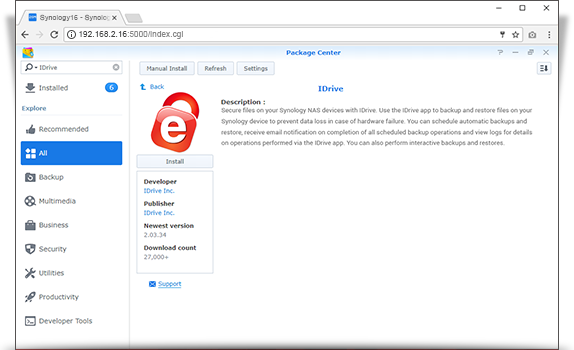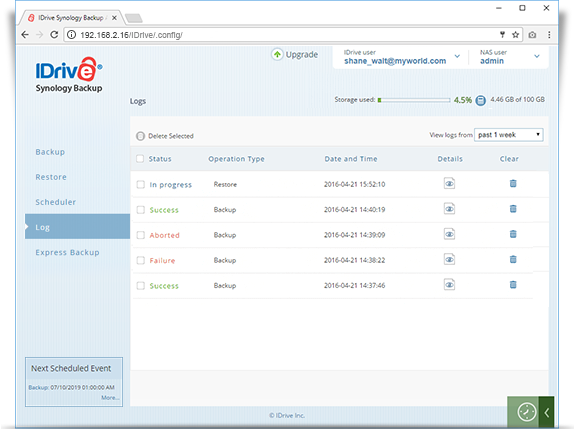
- #Install idrive on synology manual#
- #Install idrive on synology download#
- #Install idrive on synology windows#
#Install idrive on synology download#
We suggest investigating the package download support web page for each appliance to see all the apps that are available for them. Other backup apps missing on the DS220j are those that support third-party cloud providers such as iDrive and Data Deposit Box.
#Install idrive on synology windows#
The star player in this suite is the Active Backup for Business (ABB) app which provides backup, restore and disaster recovery services for Windows servers and PCs along with Hyper-V, VMware vCentre and ESXi hypervisors.
#Install idrive on synology manual#
Their CPUs may both be the 64-bit variety but only the DS220+ supports BTRFS volumes plus the Snapshot Replication and Replication Service apps which allow you to run manual and scheduled point-in-time snapshot backups of NAS shares and iSCSI LUNs.īoth will run Synology’s standard Hyper Backup app but if you want the Active Backup Suite, you should choose the DS220+.

DSM app comparisonĭSM data backup apps are in abundance but there are significant differences between these two appliances you need to be aware of. The DS220+ and its dual Gigabit ports handled an MPIO link well with Iometer reporting fast read and write speeds of 226MB/sec and 198MB/sec. If you’re tempted by IP SANs, neither appliance will disappoint as both delivered read and write rates for a 500GB iSCSI target of 113MB/sec and 107MB/sec although CPU usage for the DS220+ was half that of the DS220j.


Copying our 25GB file across from the host server saw the DS220j average 111MB/sec with a 50% CPU utilization while the DS220+ returned 113MB/sec at a cost of only 36% CPU utilization. The DS220+ is the better bet if you’re planning on using secure encrypted shares. They also handled our backup test well with a 22.4GB folder containing 10,500 small files secured to the share at 80MB/sec. Clearly, the quad CPU cores in the DS220j handled disk writes slightly more efficiently.īoth appliances delivered almost identical results in our real world test with our 25GB file copies averaging read and write rates of 113MB/sec. With a NAS share mapped over a Gigabit connection to our Dell PowerEdge T640 Windows host server, we recorded Iometer sequential read and write rates both of 113MB/sec for the DS220j and 113MB/sec and 108MB/sec for the DS220+. The DSM Drive app suite provides a wealth of file syncing and collaboration tools Overall performance for both appliances was very good although we did see some interesting variations. Performance comparisonsįor testing, we fitted two high-capacity 16TB Seagate IronWolf NAS drives in each appliance and used the DSM Storage Manager app to create RAID1 mirrored arrays. You also get twice as many Gigabit ports plus the obligatory dual USB 3 ports and we found the single cooling fans employed by both appliances were exceedingly quiet. The charcoal-black chassis has a magnetic front cover and behind this are tool-free hot-swap carriers so drive installation will be much quicker than for the DS220j. Memory is boosted to the DDR4 variety and the base 2GB can be upgraded to 6GB using the single SO-DIMM slot hidden behind the right-hand drive bay. The DS220+ replaces the DS218+ and elbows out the old 2GHz dual-core Celeron J3355 CPU with the same 2GHz dual-core Celeron J4025 as found in the new DS420+. Hard disk installation hasn’t changed either as you separate the two case halves and fit your drives in the fixed metal cage which is also designed to accommodate SSDs. The DS220j employs the same sleek white chassis and also offers a single Gigabit port and dual USB 3 ports. Both appliance have access to an impressive range of multimedia services including the Video Station and Moments app


 0 kommentar(er)
0 kommentar(er)
